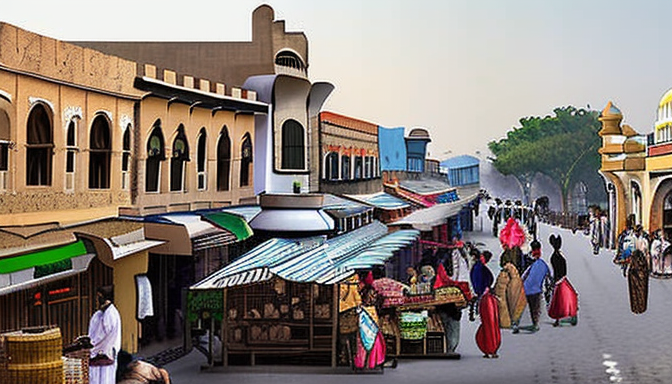Karachi’s story begins long before it became the bustling metropolis we know today. Its colonial past is like a hidden treasure chest, filled with stories of British influence that shaped the city’s very essence. From the moment the British arrived, they left an indelible mark on the architecture, urban planning, and social interactions within the city. Imagine walking through the streets of Karachi, where every corner reveals a blend of historical styles—from Gothic to Indo-Saracenic. These architectural gems, like the iconic Frere Hall and the majestic Karachi Port Trust Building, tell tales of a time when grand visions met local realities.
The policies enacted during the colonial era also played a crucial role in shaping Karachi. The British introduced urban planning concepts that organized the city into distinct areas, each serving specific purposes. This framework laid the groundwork for modern Karachi, influencing everything from residential zones to commercial hubs. The result? A city that is a patchwork of cultures and communities, each contributing to its vibrant identity.
As we explore this rich tapestry, it’s clear that Karachi’s colonial past is not just history; it’s a blueprint for understanding the city today. The echoes of those early days resonate in the way people interact, the architecture they admire, and the cultural exchanges that thrive. Karachi is a living museum, where the past and present dance together, creating a unique urban landscape that is both familiar and extraordinary.
Architectural Heritage
Karachi’s architectural heritage is like a vibrant tapestry woven from threads of history. The colonial era left a profound mark on the city, shaping its skyline and urban planning. Imagine walking down a street where Victorian buildings stand shoulder to shoulder with Art Deco structures. This mix isn’t just a feast for the eyes; it tells a story of cultural exchange and adaptation.
The British brought their architectural styles, but Karachi added its own flavor. The result? A unique blend that defines the city today. For instance, the iconic Frere Hall showcases stunning Gothic Revival elements, while the Mohatta Palace reflects a fusion of local and Western styles, making it a true architectural gem.
These buildings are more than just pretty facades; they are reminders of a time when Karachi was a bustling hub of trade and culture. The policies that the British implemented during their rule influenced urban planning. Streets were laid out with a purpose, creating a structured environment that still resonates today.
To understand Karachi’s identity, we must appreciate its architectural heritage. Each structure whispers tales of the past, inviting us to explore the city’s rich history. So, next time you stroll through Karachi, take a moment to look up. You might just see the echoes of a bygone era, beautifully preserved in the architecture around you.

Social Dynamics
Karachi’s colonial past is like a rich tapestry, woven with threads of diverse cultures and communities. The British era didn’t just leave behind buildings; it shaped the very fabric of society. Can you imagine a city where different cultures mingled and exchanged ideas? That’s Karachi for you!
During the colonial period, the city became a melting pot. People from various backgrounds arrived, each bringing their own traditions and lifestyles. This influx created a vibrant community, one that was both complex and fascinating. The British policies, aimed at urban planning and governance, played a pivotal role in this transformation. They introduced new systems, which altered social interactions and community structures.
For example, neighborhoods began to form based on ethnicity and profession. You had areas bustling with merchants, while others were home to artisans. This division wasn’t just about geography; it was about identity. The blending of these communities fostered a unique cultural exchange. Festivals, cuisines, and languages began to intermingle, enriching Karachi’s social landscape.
Even today, the echoes of that past resonate. Karachi’s streets are alive with traditions and celebrations that reflect this diverse heritage. The colonial influence is evident in the way communities interact and celebrate their differences. It’s a beautiful chaos, isn’t it?
In short, the social dynamics of Karachi, shaped by its colonial history, continue to influence the city’s identity. The past is not just a memory; it’s a living part of Karachi’s vibrant culture.
Frequently Asked Questions
- What is the significance of Karachi’s colonial architecture?
Karachi’s colonial architecture is a fascinating blend of styles that reflects its rich history. These buildings not only showcase the aesthetic preferences of the colonial era but also tell stories of the cultural exchanges that shaped the city. Each structure contributes to the unique skyline, making it a living museum of architectural evolution.
- How did the colonial period affect Karachi’s social dynamics?
The colonial period transformed Karachi into a melting pot of cultures and communities. This era introduced diverse populations, leading to vibrant cultural exchanges that continue to influence the city’s identity today. The interactions among various groups have created a rich tapestry of social dynamics that define Karachi’s character.
- Are there any notable colonial buildings to visit in Karachi?
Absolutely! Karachi is home to several remarkable colonial buildings, such as the Frere Hall, the Sindh High Court, and the Quaid-e-Azam’s Mausoleum. Visiting these sites offers a glimpse into the city’s past and an appreciation for its architectural heritage.